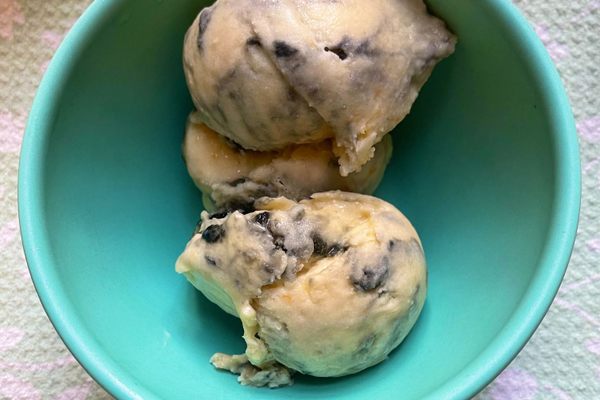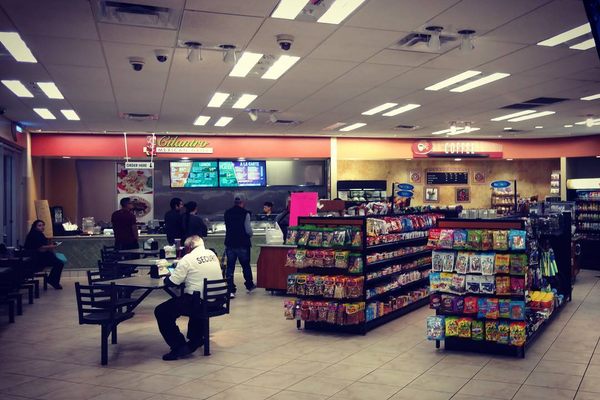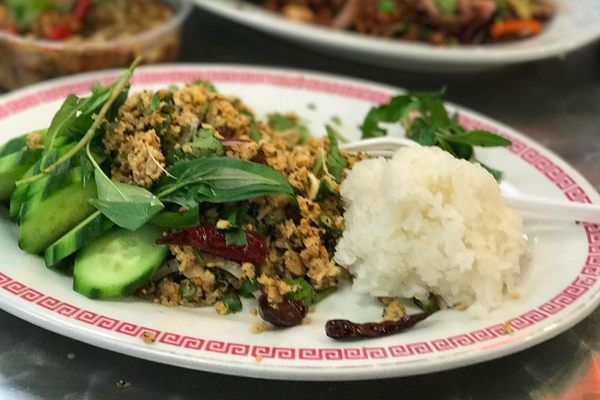

Eat Like an Apollo 11 Astronaut With This Celestial Dessert
Neil Armstrong, Richard Nixon, and Jimmy Stewart all feasted upon Clair de Lune.
On the evening of August 13, 1969, cars halted in front of the Century Plaza Hotel in Los Angeles began dispelling their 1,440 occupants: mega-stars of the Hollywood Golden Age, diplomats from dozens of countries, former and future American presidents, and some of the most lauded aeronautic inventors and pilots alive.
After cocktails, President Richard Nixon walked into the party with Neil Armstrong, Edwin E. “Buzz” Aldrin, Jr., and Michael Collins: the heroes of the hour, having accomplished the seemingly impossible task of landing upon the moon in July. Finished with their weeks-long quarantine, the astronauts were fresh off of two ticker-tape parades in New York and Chicago, and finally, a public reception in Los Angeles. Now, at the gleaming modern hotel, it was time for dinner.
But this was a dinner unlike any in history: the largest White House state dinner ever, the first held outside the White House in more than a century, and the first one ever to be televised. Not only that, but everything had to be perfect in celebration of America’s very own “Moonmen.”
It was chaos. Vietnam War protests roared outside, while inside, chef Walter Roth was putting the finishing touches on a fabulous dinner and dozens of fantastical spun-sugar sculptures. Some were destined to be the centerpieces, while others were installed within the astronauts’ hotel rooms. Roth also personally oversaw the installation of two 600-pound bald-eagle ice sculptures to loom over the hor d’oeuvres, and publicly fretted about sourcing enough ingredients to feed more than 1,400 guests. “Our biggest problem was getting enough blackberries,” noted Roth in an interview. That made sense, considering that Roth wanted only wild blackberries picked in the mountains, which had to be shipped in from Portland.
The blackberries were intended for the dinner’s dessert. After a meal of salmon Commodore poached in champagne, artichoke hearts filled with fresh green peas and diced tomatoes, French cheeses, and “A Presentation of Fresh Californian Fruits,” guests were to be treated to a brand-new confection created just for the occasion. Written as simply Clair de Lune on the menu, it gave no clues as to what it would look like, taste like, or what it contained.

But people really wanted to know what the likes of Nixon, James Stewart, and Neil Armstrong would be eating, resulting in a leaked itinerary and menu almost a month prior to the event (while the astronauts were still making their descent back to Earth) and an angry White House social secretary, who disparaged the early reveal.
The plans, noted a New York Times article, “obviously reflected the ebullient mood of President Nixon.” The same journalist also mused that the president seemed “unusually enthusiastic” about the moon landing and the ensuing celebrations. Kathryn Cramer Brownell, associate professor of history at Purdue and the author of Nixoning the Moon, says that Nixon saw the successful mission as a great opportunity to “grab on to something that has firmly been associated with his rival [John F. Kennedy] and to make it more associated with him and his administration.” But Nixon’s open-hearted embrace of the astronauts and their achievements was viewed with skepticism by many, especially considering that he cut NASA’s funding multiple times. “Many of Nixon’s critics were appalled that he was trying to lay claim to these achievements that were very much started by his Democratic predecessors,” notes Brownell.
Nixon also laid claim to nearly every detail of the party. The Los Angeles Times noted that Nixon had requested the dinner be a copy of an earlier event that he’d attended at the hotel, in honor of a Catholic cardinal. Nixon also personally approved the menu, after chef Roth presented him with three different dinner options for the night.
“White House desserts are always exceptional,” noted the Times, sailing past the fact that Roth and his staff worked for the Century Plaza and not the White House. But he was certainly taking notes from the president, and Nixon demanded two things: that the dessert be “something no one had ever seen” and that it involve ice cream. Gamely, the hotel suggested small moons made of green cheese. Nixon nixed that. “Cheese doesn’t go with ice cream,” the paper stated. “And the President wanted ice cream.”

It fell to pastry chef Ernest Mueller to come up with the ideal dessert. He settled upon individual globes of vanilla ice cream, containing kirsch-soaked raisins and marzipan, atop almond pastry. The entire confection was then covered in meringue and lightly toasted, creating a golden, cratered effect. These ice cream bombes were then surrounded with a pool of dark-purple blackberry sauce. The effect was like a golden moon on a velvety carpet of the night sky, and intensely evoked the occasion.
It was also a chance for the administration to present the image of a strong, successful, united nation. Though all eyes were ostensibly on the three astronauts, coverage of the events of August 13 reflected the cultural and political tensions of the day. “You’ve got the backdrop, of course, of the Vietnam War,” says Brownell. “You’ve got urban uprisings, a lot of divides in terms of questions about race and gender and lifestyle, sexuality…all of these things are unfolding throughout the year of 1969.”
An anti-war protest seethed in Century Plaza, near the hotel, though the organizers had been denied a city permit to situate themselves very close to the party at all. Memories were fresh of 1967, when police violently dispersed 10,000 anti-war protesters in front of the Century Plaza building, when Lyndon B. Johnson was attending a Democratic fundraising dinner.
Newspapers breathlessly covered the lead-up to the event, launching themselves at every scrap of information available. The menu was pored over obsessively, with one New York Times writer calling it downright “chauvinistic” in favor of Californian wines, vegetables, and fruits. This was despite the fact that the dinner also featured French truffles, New Zealand kiwis, and seafood from all over the States. But in a world where French food and wine was still considered the ultimate standard, many an eyebrow was raised when dinner was served with Californian chardonnay, cabernet, and champagne.

The dinner was called “splendiferous,” the entire event an “astrofête,” and the guests of honor “voyagers of the Sea of Tranquility.” But any of the gawkers outside the hotel were drawn by Earth’s own stars, with the guest list studded as it was with film and television celebrities. Nixon, says Brownell, was obsessed with television and the impact it had on the public’s opinion. With television, he “bypassed the press and [it] allowed him to connect directly to voters through a very well-crafted television image, using entertainment as a way as a tool to reach out to people.”
Plans were laid early to broadcast the three-hour dinner, and the glittering orange ballroom was laced with cables and hung with strong lights at regular intervals. The White House tapped Roger Ailes, their television expert and the future founder of Fox News, to produce the broadcast. The drumbeat of press and interest led to critics lambasting the cost and the spectacle of the event, with editorials both before and after speculating that taxpayers or NASA itself would have to foot the bill.
Politics, Hollywood, and the seeming miracle of having put a man on the moon was a heady combination, and no one knew quite how to behave. Comedian Red Skelton shrugged when he was asked why he had been invited to celebrate the moon landing. “Maybe they thought that [Vice President] Spiro Agnew wouldn’t say anything funny and they could call on me,” he said. The astronauts themselves, obviously weary by the mad dash across the country, each gave simple, heartfelt speeches after the president awarded them Medals of Freedom. “All mankind took a trip,” Armstrong told the glittering crowd in a choked voice. “We were very privileged to leave on the moon a plaque endorsed by you, Mr. President, saying that it was for all mankind.”
Behind the scenes, chefs trudged through a waterlogged kitchen, after the radiating heat from ovens and stoves at full blast triggered a ceiling sprinkler. The guests, meanwhile, were as dazzled by one another as with the astronauts up at the high table with Nixon, and conversation stayed at a roar the entire night. Even some of the protestors outside took a load off, with a handful taking a dip in the plaza fountain at midnight.
Music played throughout the event, with a particular emphasis on space. Of course, the best was saved for last: As waiters brought out Clair de Lune for every guest, the band launched into “Fly Me to the Moon.”

Clair de Lune
Ingredients
- Two cups plus 4 tablespoons of vanilla ice cream, softened
- ¼ cup raisins
- ¼ cup kirsch
- One tube of marzipan, such as Odense
- 1 1/2 cups blackberries
- ¼ cup granulated sugar
- Two egg whites
- 1/2 cup powdered sugar
Instructions
-
Line 4 ramekins (small bowls or muffin tins also work) with plastic wrap, making sure to leave an overhang. Fill each with vanilla ice cream, pressing down to make sure no air bubbles are present.
-
With a warm spoon, dig or melt a deep hollow into the center of each serving of ice cream. Then, leave the ramekins in the freezer for several hours, to harden completely.
-
While you wait, combine the raisins with the kirsch and allow them to soak.
-
Put the blackberries and the sugar into a small pot on the stove. Over medium heat, stir and mash the berries with a spoon so that a sauce forms. When the berries bubble, remove the sauce from the heat and allow it to cool. Once it’s mostly cool, put the sauce through a sieve. Put the smooth sauce aside.
-
Take the marzipan and pinch off four pieces, each a little smaller than a ping-pong ball. Place each one between two sheets of wax paper, and roll them flat, to about the size of the bottom of the ice-cream bowls.
-
Once the ice cream in the freezer is completely hard to the touch, take out all 4 ramekins. Fill the hollows of each serving with the raisins, and cover with a small amount of extra ice cream. Place back into the freezer to wait for serving.
-
Before serving, whip the egg whites and the powdered sugar together until the meringue forms stiff peaks. Then, remove the ice cream from the freezer.
-
Place each circle of marzipan onto individual, heat-safe plates. Using the plastic wrap or a thin-bladed knife as a lever, pull each ice cream from its container and place it, flat-side down, onto the marzipan. Spread the meringue over each serving, doming it on top. Divots are fine; they will make it look even more like the moon!
-
Using a blowtorch or a broiler on high, toast the meringue until a light golden brown.
- Pour the cool blackberry sauce around each ice cream. Garnish with a paper American flag and serve immediately.
Gastro Obscura covers the world’s most wondrous food and drink.
Sign up for our email, delivered twice a week.
































Follow us on Twitter to get the latest on the world's hidden wonders.
Like us on Facebook to get the latest on the world's hidden wonders.
Follow us on Twitter Like us on Facebook